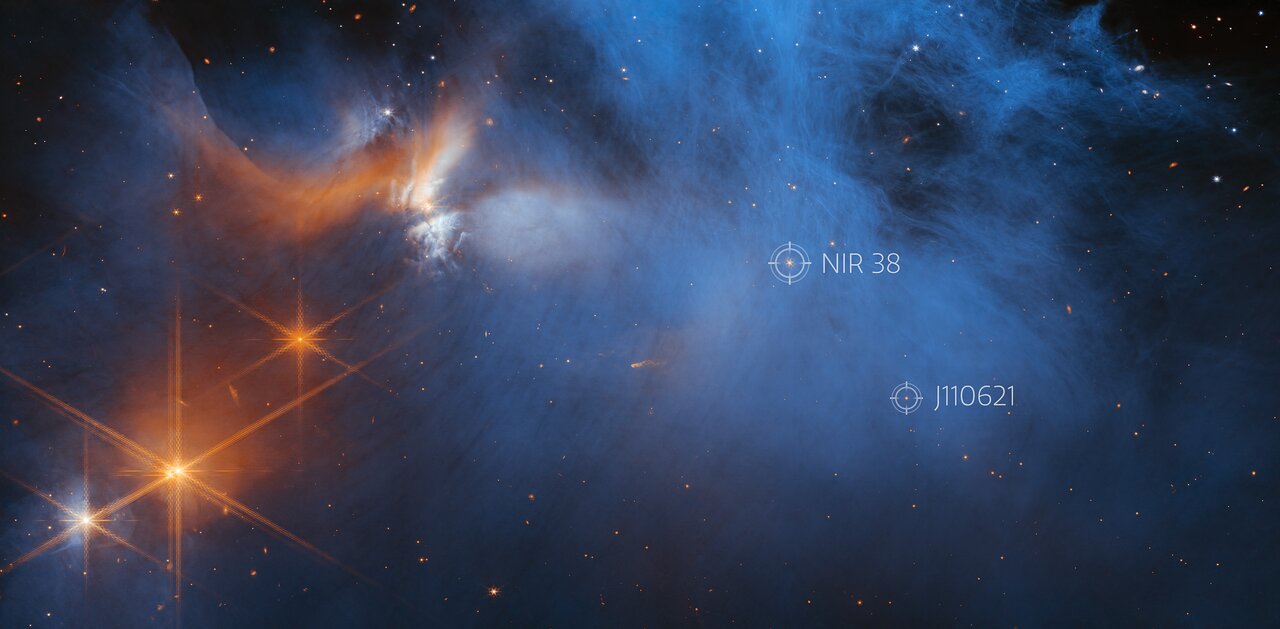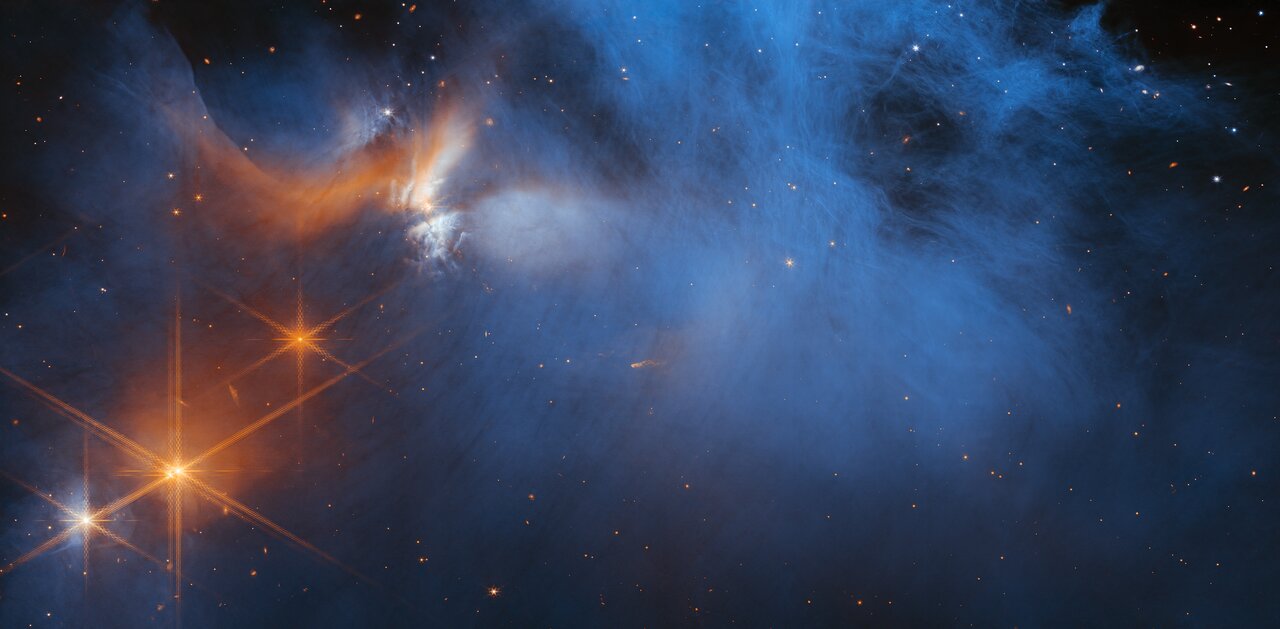James Webb Space Telescope Discovery
Clicking on each image will open the full resolution one. Try it!Clicking on "Raw images" image will yield all the relevant raw images.
Webb’s View of the Molecular Cloud Chameleon I
This image by the NASA/ESA/CSA James Webb Space Telescope’s Near-InfraRed Camera (NIRCam) features the central region of the Chameleon I dark molecular cloud, which resides 630 light years away. The cold, wispy cloud material (blue, centre) is illuminated in the infrared by the glow of the young, outflowing protostar Ced 110 IRS 4 (orange, upper left). The light from numerous background stars, seen as orange dots behind the cloud, can be used to detect ices in the cloud, which absorb the starlight passing through them.
An international team of astronomers has reported the discovery of diverse ices in the darkest, coldest regions of a molecular cloud measured to date by studying this region. This result allows astronomers to examine the simple icy molecules that will be incorporated into future exoplanets, while opening a new window on the origin of more complex molecules that are the first step in the creation of the building blocks of life.
The two background stars used in this study, NIR38 and J110621 are denoted on the image in white.
Credit: NASA, ESA, CSA, and M. Zamani (ESA/Webb); Science: F. Sun (Steward Observatory), Z. Smith (Open University), and the Ice Age ERS Team.
 Webb’s View of the Molecular Cloud Chameleon I (Annotated)
Webb’s View of the Molecular Cloud Chameleon I (Annotated)
 Webb’s View of the Molecular Cloud Chameleon I
Webb’s View of the Molecular Cloud Chameleon I
 Chameleon I Spectral Graphic
Astronomers have taken an inventory of the most deeply embedded ices in a cold molecular cloud to date. They used light from a background star, named NIR38, to illuminate the dark cloud called Chameleon I. Ices within the cloud absorbed certain wavelengths of infrared light, leaving spectral fingerprints called absorption lines. These lines indicate which substances are present within the molecular cloud.
These graphs show spectral data from three of the James Webb Space Telescope’s instruments. In addition to simple ices like water, the science team was able to identify frozen forms of a wide range of molecules, from carbon dioxide, ammonia, and methane, to the simplest complex organic molecule, methanol.
In addition to the identified molecules, the team found evidence for prebiotic molecules more complex than methanol (indicated in the lower-right panel). Although they didn't definitively attribute these signals to specific molecules, this proves for the first time that complex molecules form in the icy depths of molecular clouds before stars are born.
The upper panels and lower-left panel all show the background star’s brightness versus wavelength. A lower brightness indicates absorption by ices and other materials in the molecular cloud. The lower-right panel displays the optical depth, which is essentially a logarithmic measure of how much light from the background star gets absorbed by the ices in the cloud. It is used to highlight weaker spectral features of less abundant varieties of ice.
Credit: NASA, ESA, CSA, and J. Olmsted (STScI), M. K. McClure (Leiden Observatory), K. Pontoppidan (STScI), N. Crouzet (Leiden University), and Z. Smith (Open University)
Chameleon I Spectral Graphic
Astronomers have taken an inventory of the most deeply embedded ices in a cold molecular cloud to date. They used light from a background star, named NIR38, to illuminate the dark cloud called Chameleon I. Ices within the cloud absorbed certain wavelengths of infrared light, leaving spectral fingerprints called absorption lines. These lines indicate which substances are present within the molecular cloud.
These graphs show spectral data from three of the James Webb Space Telescope’s instruments. In addition to simple ices like water, the science team was able to identify frozen forms of a wide range of molecules, from carbon dioxide, ammonia, and methane, to the simplest complex organic molecule, methanol.
In addition to the identified molecules, the team found evidence for prebiotic molecules more complex than methanol (indicated in the lower-right panel). Although they didn't definitively attribute these signals to specific molecules, this proves for the first time that complex molecules form in the icy depths of molecular clouds before stars are born.
The upper panels and lower-left panel all show the background star’s brightness versus wavelength. A lower brightness indicates absorption by ices and other materials in the molecular cloud. The lower-right panel displays the optical depth, which is essentially a logarithmic measure of how much light from the background star gets absorbed by the ices in the cloud. It is used to highlight weaker spectral features of less abundant varieties of ice.
Credit: NASA, ESA, CSA, and J. Olmsted (STScI), M. K. McClure (Leiden Observatory), K. Pontoppidan (STScI), N. Crouzet (Leiden University), and Z. Smith (Open University)
 Raw images
Raw images